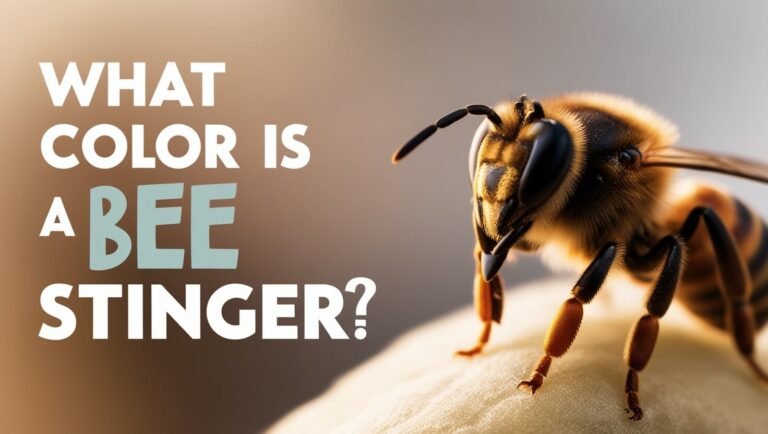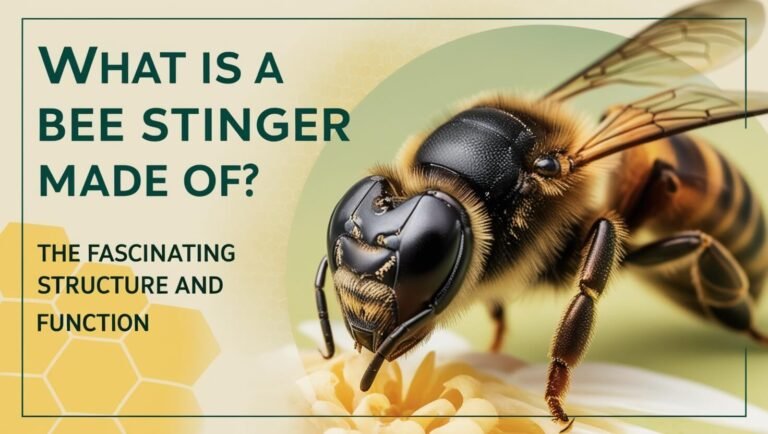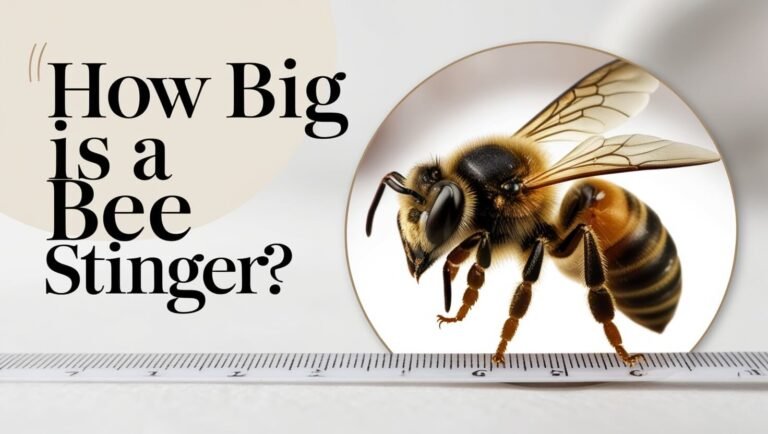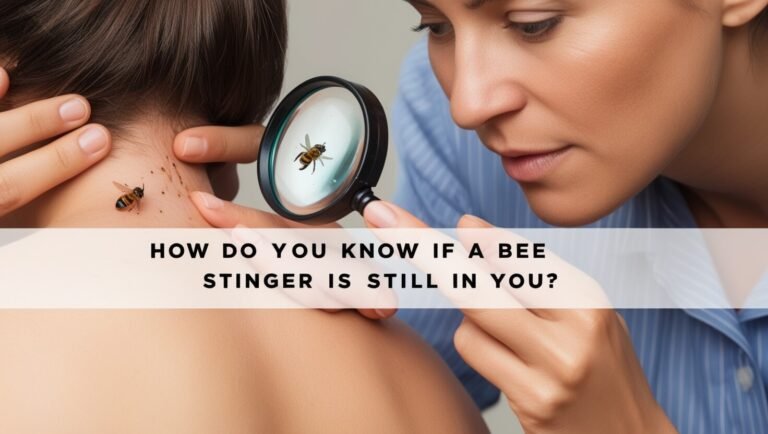What If A Bee Stinger Is Not Removed: Risks and What to Do
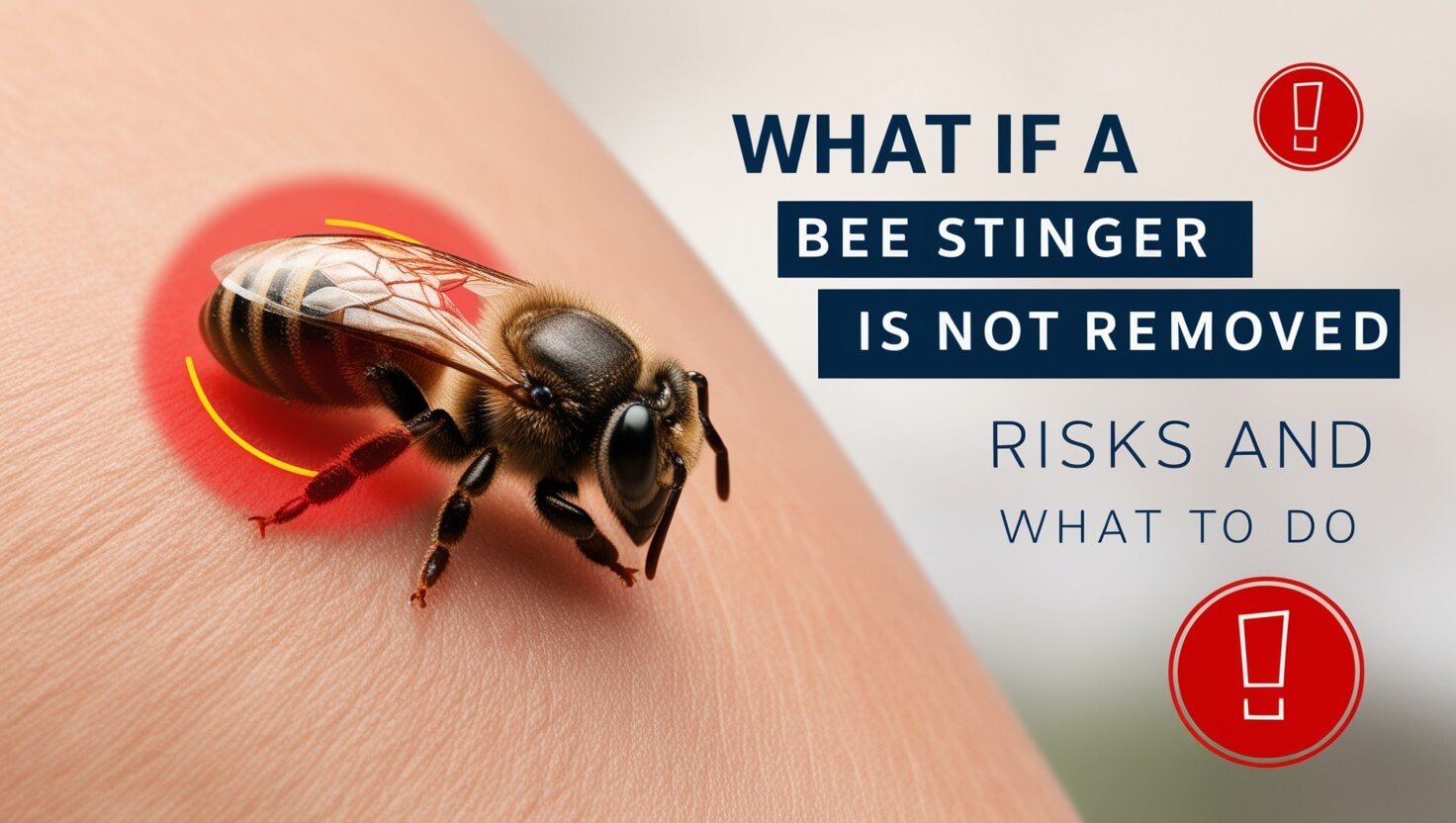
Bee stings can be a painful and sometimes dangerous experience. But what happens if you don’t remove the stinger? If a bee stinger is not removed, it continues to pump venom into your skin, causing increased pain, swelling, and potentially more serious reactions. Quick removal is crucial to minimize these effects and prevent complications.
In this comprehensive guide, we’ll explore the consequences of leaving a bee stinger in your skin, how to properly remove it, and what to do if you can’t get it out. We’ll also cover prevention strategies and when to seek medical help. Whether you’re an outdoor enthusiast or just want to be prepared, this information could save you from unnecessary discomfort or even a trip to the emergency room.
Understanding Bee Stings
Before we dive into what happens when a stinger isn’t removed, let’s first understand the basics of bee stings and the insects responsible for them.
Types of Stinging Insects
While we often focus on honeybees, several insects can deliver painful stings:
- Honeybees
- Bumblebees
- Wasps
- Hornets
- Yellowjackets
Each of these insects has a different stinging mechanism, but honeybees are unique in that they typically leave their stinger behind.
Anatomy of a Bee Sting
A bee’s stinger is a complex organ:
- Barbed tip: Helps the stinger stay embedded in the skin
- Venom sac: Contains the bee’s venom
- Muscles: Continue to contract after the sting, pumping more venom
Understanding this structure helps explain why leaving a stinger in can be problematic.
How Bees Lose Their Stingers
When a honeybee stings, its barbed stinger gets stuck in the victim’s skin. As the bee flies away, it literally tears itself apart, leaving behind the stinger and attached venom sac. This is why honeybees can only sting once – it’s a sacrificial act of defense.
Immediate Effects of Leaving a Bee Stinger In
Now, let’s address the core question: what if the bee stinger is not removed? The consequences begin immediately and can worsen over time.
Continued Venom Release
The most immediate effect of not removing a bee stinger is the continued release of venom. The venom sac attached to the stinger can continue pumping venom for up to 10 minutes after the initial sting. This means:
- More venom enters your body
- Pain intensifies
- Swelling increases
- Risk of a severe reaction rises
Increased Pain and Swelling
As more venom enters your system, you’ll likely experience:
- Sharp, burning pain at the sting site
- Redness and warmth around the area
- Swelling that may expand over 24-48 hours
In some cases, this swelling can be quite dramatic, especially if the sting is on a sensitive area like the face or neck.
Risk of Infection
Leaving the stinger in your skin also increases the risk of infection. The stinger is a foreign object, and like any puncture wound, it can introduce bacteria into your body. Signs of infection may include:
- Increased redness and warmth
- Pus or discharge from the sting site
- Fever
- Swelling that doesn’t improve after a few days
Long-Term Consequences of Not Removing a Bee Stinger
While the immediate effects are uncomfortable, leaving a bee stinger in can also lead to longer-term issues.
Prolonged Inflammation
The continuous release of venom can cause prolonged inflammation in the affected area. This can lead to:
- Persistent pain and tenderness
- Difficulty using the affected body part
- Slower healing process
Tissue Damage
In rare cases, the venom from a bee sting can cause localized tissue damage. This is more likely if the stinger is left in for an extended period and can result in:
- Skin discoloration
- Scarring
- In extreme cases, necrosis (tissue death)
Allergic Reactions Over Time
Repeated exposure to bee venom, which can happen if stingers are frequently left in, may increase your risk of developing an allergy to bee stings. This can make future stings more dangerous, potentially leading to severe allergic reactions or even anaphylaxis.
Identifying a Bee Stinger in Your Skin
Knowing how to spot a bee stinger is crucial for quick removal. Here’s what to look for:
Visual Cues
A bee stinger often looks like a tiny dark splinter in your skin. You might also see:
- A small, raised bump
- A visible stinger protruding from the center of the bump
- The venom sac attached to the end of the stinger, which may look like a tiny balloon
Physical Sensations
Besides visual cues, you might experience:
- A sharp, burning pain
- An intense itching sensation
- A feeling of something stuck in your skin
Differentiating Between Stinger Types
It’s worth noting that not all stinging insects leave their stingers behind:
- Honeybees typically leave their stinger
- Wasps, hornets, and bumblebees usually don’t leave a stinger behind
If you’ve been stung but don’t see a stinger, you likely encountered a different type of insect.
Proper Techniques for Removing a Bee Stinger
If you’ve identified a bee stinger in your skin, it’s crucial to remove it quickly and correctly. Here are the best methods:
Scraping Method
This is often considered the best approach:
- Use a straight-edged object like a credit card or driver’s license
- Gently scrape across the skin, perpendicular to the stinger
- Continue until the stinger pops out
This method helps avoid squeezing the venom sac, which could release more venom.
Tweezer Technique
If you don’t have a card handy, tweezers can work:
- Grasp the stinger as close to the skin as possible
- Pull straight out in one smooth motion
Be careful not to squeeze the venom sac at the end of the stinger.
Common Mistakes to Avoid
When removing a bee stinger, don’t:
- Use your fingernails to pinch the stinger out (this can squeeze the venom sac)
- Delay removal to look for tools (speed is more important than method)
- Dig into the skin if you can’t see the stinger (this can cause more damage)
Remember, the faster you remove the stinger, the less venom will enter your body.
What to Do If You Can’t Remove the Bee Stinger
Sometimes, despite your best efforts, you might not be able to remove the stinger. Here’s what to do:
Seeking Medical Help
If you can’t remove the stinger or if it’s in a difficult-to-reach area:
- Visit a healthcare provider or urgent care center
- They have tools and expertise to safely remove the stinger
- They can also assess for any signs of severe reaction or infection
Home Remedies to Alleviate Symptoms
While waiting for medical help, you can try these remedies:
- Apply a cold compress to reduce swelling
- Take an over-the-counter antihistamine to help with itching
- Use a pain reliever like ibuprofen if needed
When to Visit the Emergency Room
Seek immediate medical attention if you experience:
- Difficulty breathing
- Swelling of the throat or tongue
- Dizziness or fainting
- Nausea or vomiting
- A rapid pulse
These could be signs of a severe allergic reaction, which can be life-threatening.
Treating the Sting Site After Stinger Removal
Once the stinger is out, proper care can help reduce discomfort and prevent complications.
Cleaning the Area
First, clean the sting site:
- Wash the area with soap and water
- Pat dry gently with a clean towel
- Apply an antiseptic if available
This helps prevent infection and removes any remaining venom on the skin surface.
Applying Cold Compresses
Cold can help reduce pain and swelling:
- Apply an ice pack wrapped in a thin cloth
- Keep it on for 10-15 minutes at a time
- Repeat every hour as needed
Over-the-Counter Treatments
Several OTC products can help manage symptoms:
- Hydrocortisone cream for itching and inflammation
- Calamine lotion for itching and pain
- Oral antihistamines for overall symptom relief
Always follow the instructions on the product label.
Preventing Allergic Reactions from Bee Stings
For some people, bee stings can trigger severe allergic reactions. Here’s what you need to know:
Recognizing Signs of an Allergic Reaction
Watch for these symptoms after a sting:
- Widespread hives or rash
- Swelling away from the sting site
- Difficulty breathing or wheezing
- Dizziness or fainting
- Nausea or vomiting
If you experience these, seek medical help immediately.
Using Epinephrine Auto-Injectors
If you have a known bee sting allergy:
- Carry an epinephrine auto-injector (like an EpiPen) at all times
- Know how to use it properly
- Teach friends and family how to use it in case you can’t
Allergy Testing and Immunotherapy
If you’ve had a severe reaction to a bee sting:
- Consider allergy testing to confirm the allergy
- Discuss immunotherapy (allergy shots) with your doctor
- This can help reduce your sensitivity to bee venom over time
Myths and Facts About Bee Stinger Removal
There’s a lot of misinformation out there about bee stings. Let’s separate fact from fiction:
Debunking Common Misconceptions
Myth: You should use tweezers to remove a bee stinger. Fact: While tweezers can work, scraping is often better to avoid squeezing the venom sac.
Myth: Applying meat tenderizer to a sting neutralizes the venom. Fact: There’s no scientific evidence to support this claim.
Myth: If you’re stung once, you’re immune to future stings. Fact: You can develop an allergy to bee stings at any time, even after many stings.
Scientific Evidence on Stinger Removal
Research shows:
- Speed of removal is more important than the method used
- Most venom is injected within the first few seconds
- Leaving the stinger in longer than 30 seconds significantly increases the amount of venom received
Expert Opinions on Best Practices
Most allergists and emergency medicine doctors agree:
- Remove the stinger as quickly as possible
- Use whatever method is immediately available
- Seek medical help for signs of severe allergic reaction
Long-Term Health Implications of Frequent Bee Stings
For those who encounter bees often, like beekeepers, there can be long-term effects:
Developing Immunity
Some people may develop a degree of immunity to bee venom over time:
- This can result in less severe local reactions
- However, it doesn’t guarantee protection against severe allergic reactions
Chronic Health Issues
Frequent stings might lead to:
- Chronic pain or sensitivity at sting sites
- Increased risk of developing allergies
- In rare cases, organ damage from accumulated venom
Psychological Effects
Repeated bee stings can also have psychological impacts:
- Development of apiphobia (fear of bees)
- Anxiety about outdoor activities
- Stress related to potential future stings
Special Considerations for Different Body Parts
The location of a bee sting can affect its severity and treatment approach.
Stings on the Face or Neck
Stings in these areas can be more dangerous:
- Swelling can interfere with breathing
- They’re more likely to cause severe reactions
- Remove stingers quickly and watch closely for signs of trouble
Stings in the Mouth or Throat
If stung inside the mouth or throat:
- Seek immediate medical attention
- Suck on ice or an ice pop to reduce swelling
- Be prepared for emergency treatment if swelling affects breathing
Stings on Hands and Feet
Stings on extremities can be particularly painful:
- Remove jewelry in case of swelling
- Elevate the affected limb to reduce swelling
- Be extra cautious if stung on the hands if you have circulation issues
Bee Sting Prevention Strategies
The best way to avoid complications from bee stings is to prevent them in the first place.
Protective Clothing
When in areas with bees:
- Wear long sleeves and pants
- Choose light-colored clothing (bees are attracted to dark colors)
- Avoid loose clothing where bees could get trapped
Avoiding Bee Attractants
Bees are drawn to certain things:
- Sweet smells (perfumes, scented lotions)
- Bright floral patterns on clothing
- Open food and drinks, especially sweet ones
Minimize these when outdoors to reduce your risk of stings.
Safe Behavior Around Bees
If you encounter bees:
- Stay calm and move slowly
- Don’t swat at them or flail your arms
- If attacked, cover your face and move away quickly
Remember, bees generally only sting as a defense mechanism.
When to Seek Emergency Care for a Bee Sting
While most bee stings are merely uncomfortable, some can be life-threatening.
Symptoms of Severe Allergic Reactions
Watch for these signs of a severe reaction:
- Difficulty breathing or wheezing
- Swelling of the throat or tongue
- Dizziness or fainting
- Nausea or vomiting
- Rapid pulse or drop in blood pressure
If you experience any of these, call emergency services immediately.
Anaphylaxis and Its Dangers
Anaphylaxis is a severe, potentially fatal allergic reaction:
- It can occur within minutes of a sting
- It affects multiple body systems
- Without prompt treatment, it can lead to shock, unconsciousness, and even death
Emergency Treatment Protocols
If someone is having a severe reaction:
- Call emergency services immediately
- Use an epinephrine auto-injector if available
- Have the person lie down with feet elevated
- Monitor breathing and pulse
- Be prepared to perform CPR if needed
Emergency responders will provide additional treatment upon arrival.
Final Checkpoint: The Importance of Prompt Bee Stinger Removal
So, what if a bee stinger is not removed? As we’ve explored, leaving a bee stinger in your skin can lead to increased pain, swelling, and risk of severe allergic reactions. The venom sac attached to the stinger continues to pump venom into your body, potentially causing more damage the longer it remains.
Quick removal of the stinger is crucial to minimize these effects. Remember:
- Speed is more important than the method of removal
- Scraping the stinger out is often the best approach
- Clean and treat the area after removal
- Watch for signs of allergic reaction
By understanding the risks and knowing how to properly handle a bee sting, you can significantly reduce your chances of complications. Whether you’re a nature enthusiast, a gardener, or just someone who enjoys outdoor activities, being prepared for bee stings is an important part of staying safe and healthy.
Remember, while bee stings are usually just a painful nuisance, they can sometimes be serious. If you have any doubts about your reaction to a sting, don’t hesitate to seek medical attention. Your health and safety should always come first when dealing with bee stings or any other potential medical issue.

